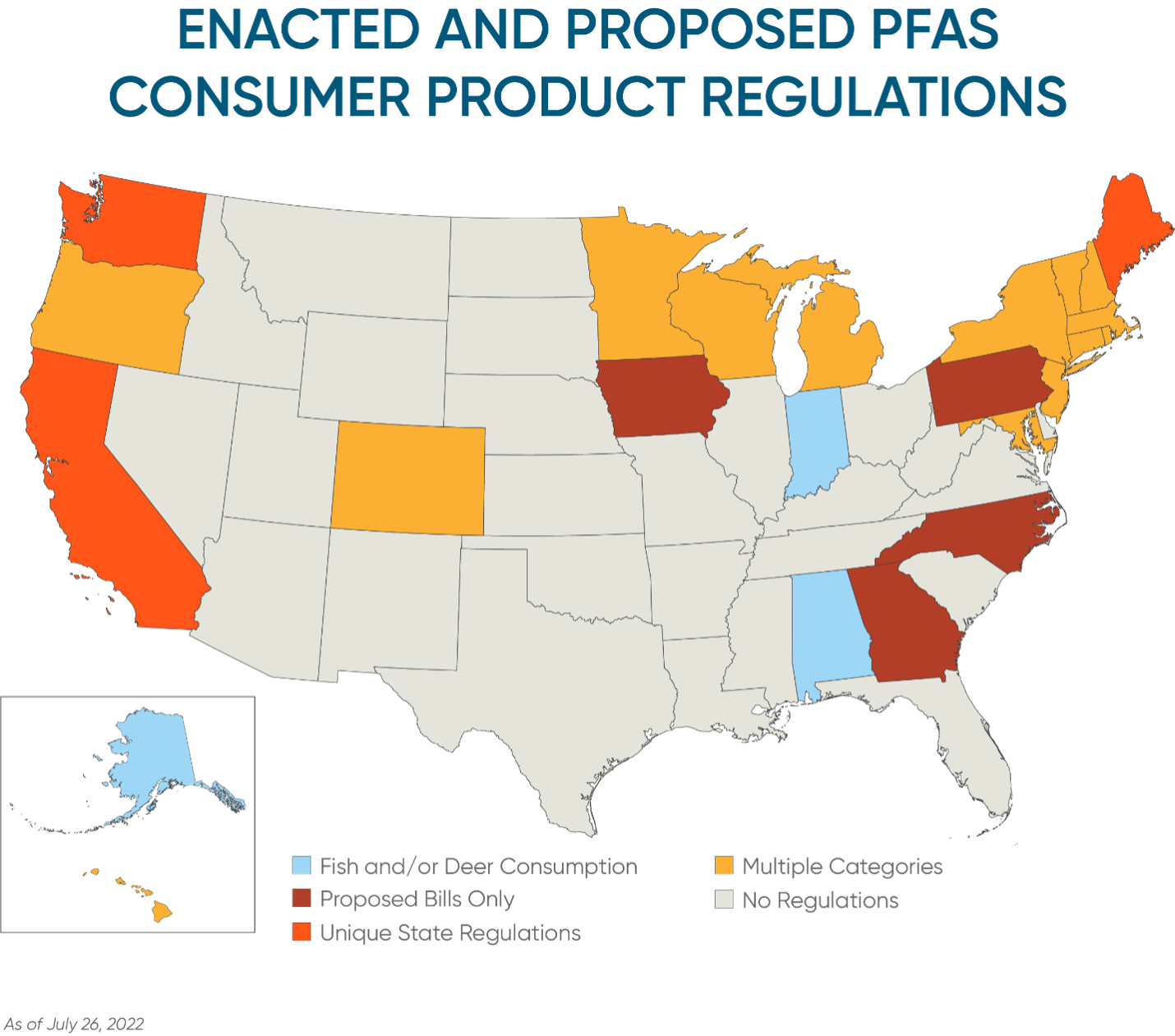Insights
PFAS Update: July 2022 State-by-State Consumer Products Regulations
Jul 27, 2022This insight was originally published in July 2022. Visit our up-to-date blog on PFAS in consumer products: state-by-state regulations >
Manufacturers, distributors, and retailers of consumer products across a broad spectrum of industries are being impacted by regulations regarding the presence of per- and polyfluoroalkyl substances (“PFAS”) in their products. This area is rapidly developing as states create new laws, and the penalties and litigation risk for non-compliance can be significant.
While this article focuses on state laws and regulations, we note that the House of Representatives passed the PFAS Action Act of 2021 on July 21, 2021, which among other things, includes provisions regarding labeling requirements for certain consumer products (see section 10 of the Act for additional information). While the Senate still needs to approve this Bill, it demonstrates that federal attention has been directed to PFAS consumer products issues, and that federal action in this area is reasonably likely.
PFAS is a family of chemicals comprised of over 8,000 compounds, and it may be significantly higher considering how a PFAS substance is defined. According to the Agency for Toxic Substances and Disease Registry (“ATSDR”), PFAS have been reported in certain consumer products, including the following:
- some grease-resistant paper, fast food containers, microwave popcorn bags, pizza boxes, and candy wrappers;
- nonstick cookware (e.g., Teflon);
- stain resistant coatings used on upholstery or other fabrics;
- water resistant clothing such as “durable water repellent clothing";
- cleaning products;
- personal care products (e.g., shampoo, dental floss) and cosmetics (e.g., nail polish, eye makeup); and
- paints, varnishes or sealants.
Some sources, such as the United States Environmental Protection Agency (“EPA”), also states that certain PFAS chemicals accumulate both in the human body and animals since PFAS can be ingested through water and food. Accordingly, certain states have enacted health advisories limiting the consumption of deer meat and fish tissue.
I. Specific Consumer Product Regulations
States have taken many different approaches to regulating consumer products containing PFAS. State regulations of PFAS in consumer products have principally focused on the following product sectors thus far, but these categories are not exclusive:
- Food Packaging;
- Cosmetics or Personal Care Products;
- Children’s Products;
- Textiles, Fabrics, Carpets or Rugs, and Upholstery; and
- The Consumption of Fish Tissue and Deer Meat.
Below is an overview of enacted and proposed state laws and regulations as of July 26, 2022, to assist you in investigating whether your products may be impacted.

The following chart identifies what specific product categories each state regulates, but does not include the specific regulatory levels or requirements to avoid confusion because the structure and limits vary widely from state to state.
|
State |
Product Categories |
Regulatory Status |
Reference and Details |
|
Alabama |
Fish Consumption |
Advisory |
The Alabama Department of Health has issued limitations for fish consumption from one reservoir and two creeks |
|
Alaska |
Fish Consumption |
Advisory |
The Alaska Department of Health and Social Services has issued limitations for fish consumption in one lake |
|
California |
Proposition 65: All consumer products sold to California consumers may require warnings if these products contain PFOA, PFOS and PFOS salts and transformation and degradation precursors, and PFNA above safe harbor levels |
Enacted |
|
|
Cosmetics |
Enacted |
||
|
Rugs and Carpets |
Enacted |
||
|
1) Cookware; and 2) Food Packaging |
Enacted |
||
|
Children’s Products |
Enacted |
||
|
Recycling |
Enacted |
||
|
Composting |
Enacted |
||
|
Textiles |
Proposed |
||
|
Cosmetics (Additional) |
Proposed |
||
|
Public Disclosure for all Consumer Products |
Proposed |
||
|
Colorado |
1) Carpets and Rugs; 2) Fabric Treatments; 3) Food Packaging; 4) Children’s Products; 5) Oil and Gas Products; 6) Cookware – certain labelling requirements; 7) Cosmetics; 8) Indoor and Outdoor Textile Furnishings; and 9) Indoor and Outdoor Upholstered Furniture
|
Enacted |
|
|
Connecticut |
Food Packaging |
Enacted |
|
|
Fish Consumption |
Advisory |
The Connecticut Department of Energy and Environmental Protection has issued an Advisory for fish consumption in numerous locations |
|
|
Georgia |
1) Food Packaging; and 2) Children’s Products |
Proposed |
|
|
Hawaii |
Food Packaging |
Enacted |
|
|
Recycling |
Proposed |
||
|
Indiana |
Fish Consumption |
Advisory |
Three state agencies have issued limitations for fish consumption from rivers, streams, and lakes for various contaminants, including PFOS substances |
|
Iowa |
Food Packaging |
Proposed |
|
|
Furniture |
Proposed |
||
|
Maine |
PFOS as a “Priority Chemical” in Children’s Products |
Enacted |
|
|
Food Packaging |
Enacted |
||
|
Pesticides |
Enacted |
|
|
|
Carpets, Rugs, and Fabric Treatments |
Enacted |
||
|
Prohibiting PFAS in all products by 2030 and reporting requirements |
Enacted |
||
|
Fish Consumption |
Advisory |
Remedial Action Guidelines for Certain Types of Fish and the Department of Inland Fisheries and Wildlife Fish Consumption Advisory |
|
|
Deer Restrictions |
Advisory |
One “do not eat” restriction has been issued for a certain five-mile area |
|
|
Maryland |
Cosmetics |
Enacted |
|
|
1) Food Packaging; and 2) Rugs and Carpets |
Enacted |
||
|
Fish Consumption |
Advisory |
The Maryland Department of the Environment has issued limitations for fish consumption in one creek for PFOS substances |
|
|
Pesticides |
Proposed |
||
|
Recycling |
Proposed |
||
|
Massachusetts |
Fish Consumption |
Advisory |
The Massachusetts Department of the Environment has issued limitations for fish consumption in five ponds |
|
Food Packaging |
Proposed |
||
|
Mosquito Management |
Proposed |
||
|
Various Consumer Products: 1) Child Passenger Restraints; 2) Cookware; 3) Fabric Treatments; 4) Personal Care Products; 5) Rugs and Carpets; 6) Upholstered Furniture; and 7) Children’s Products |
Proposed |
||
|
Michigan |
Fish Consumption |
Advisory |
The Michigan Department of Health and Human Services has issued limitations for fish consumption depending on the specific location |
|
Deer Restrictions |
Advisory |
One “do not eat” restriction has been issued for a certain three-mile area |
|
|
Labeling of Consumer Products containing PFAS Substances |
Proposed |
SB 0217 |
|
|
Food Packaging |
Proposed |
HB 5250 |
|
|
Minnesota |
Food Packaging |
Enacted |
|
|
Fish Consumption |
Advisory |
The Minnesota Department of Health has issued limitations for fish consumption from certain bodies of water |
|
|
Food Packaging (Additional) |
Proposed |
||
|
Composting |
Proposed |
||
|
Prohibit PFAS substances in Cannabis Packaging |
Proposed |
||
|
Cookware |
Proposed |
||
|
Cosmetics |
Proposed |
||
|
Ski Wax |
Proposed |
||
|
Disclosure of Consumer Products containing PFAS Substances |
Proposed |
||
|
Clothing and Apparel |
Proposed |
||
|
Children’s Products |
Proposed |
||
|
Carpets and Textiles |
Proposed |
||
|
PFAS funding, PFAS disclosures or notifications, and PFAS in the following products: 1) Carpets and Rugs; 2) Fabric Treatments; 3) Upholstered Furniture; 4) Textile Furnishings; 5) Cookware; 6) Cosmetics; and 7) Ski Wax |
Proposed |
||
|
New Hampshire |
Fish Consumption |
Advisory |
The New Hampshire Department of Environmental Services has issued limitations for fish consumption from five lakes |
|
1) Disclosure of Consumer Products containing PFAS Substances; 2) Carpets, Rugs, and Fabric Treatments; and 3) Prohibiting PFAS in All Products by 2030 |
Proposed |
||
|
New Jersey |
Fish Consumption |
Advisory |
The New Jersey Department of Environmental Protection has issued limits for fish consumption the high risk and general populations (See pg. 9) |
|
Recycling |
Proposed |
||
|
New York |
Children’s Products |
Enacted |
|
|
Food Packaging |
Enacted |
||
|
Fish Consumption |
Advisory |
The New York State Department of Health has issued limitations for fish consumption from multiple waterways in one region |
|
|
Carpets |
Proposed |
||
|
Apparel |
Proposed |
||
|
General Packaging |
Proposed |
||
|
Anti-Fogging Sprays and Wipes |
Proposed |
||
|
Cosmetics/Personal Care Products |
Proposed |
||
|
Prevent Incineration of PFAS Substances |
Proposed |
||
|
Feminine Hygiene Products |
Proposed |
||
|
Prohibiting PFAS in the following products: 1) Cleaning Products; 2) Air Care Products; 3) Automotive Products; 4) Cookware; 5) Fabric Treatments; 6) Rugs; 7) Ski Wax; 8) Textiles and Textile Articles; 9) Outdoor Apparel; 10) Architectural Paints; 11) Personal Protective Equipment; 12) Polishes or Floor Products; |
Proposed |
||
|
Prohibiting PFAS in All Products by 2030 and PFAS in the following products: 1) Carpets and Rugs; 2) Cookware; 3) Cosmetics; 4) Fabric Treatments; and 5) Personal Care Products |
Proposed |
||
|
North Carolina |
Use and Manufacturing |
Proposed |
S 638 |
|
General Packaging |
Proposed |
HB 1113 |
|
|
Oregon |
Children’s Products |
Enacted |
Toxic Free Kids Act: 431A.250 et al. |
|
Fish Consumption |
Advisory |
The Oregon Health Authority has issued guidelines recommending limitations for fish consumption depending on the specific location because of various contaminants, including PFOS substances |
|
|
Pennsylvania |
Food Packaging |
Proposed |
|
|
Rhode Island |
Food Packaging |
Enacted |
|
|
Food Packaging and Warning Labels for Clothing or Carpeting |
Proposed |
||
|
Various Consumer Products: 1) Rugs and Carpets; 2) Fabric Treatments; 3) Upholstered Furniture; 4) Textiles; 5) Apparel; 6) Cosmetics; 7) Children’s Products; and 8) Cookware |
Proposed |
||
|
Vermont |
Children’s Products |
Enacted |
|
|
Food Packaging |
Enacted |
||
|
Rugs, Carpets, and Aftermarket Stain and Water Resistant Treatments |
Enacted |
||
|
Ski Wax |
Enacted |
||
|
Labeling for Certain Consumer Products |
Proposed |
||
|
1) Prohibiting PFAS in All Products by 2030; and 2) Cookware and Utensils |
Proposed |
||
|
Cosmetics |
Proposed |
||
|
1) Cosmetics; and 2) Athletic Turf Fields |
Proposed |
||
|
Prohibit Use of PFAS Products Sold in Vermont |
Proposed |
||
|
Washington |
Food Packaging |
Enacted |
|
|
Children’s Products |
Enacted |
||
|
Pollution Prevention for Our Future Act, identifying various “priority” consumer products using PFAS substances |
Enacted |
||
|
Regulate PFAS Consumer Products identified in the Chemical Action Plan |
Enacted |
||
|
Cosmetics |
Proposed |
||
|
Wisconsin |
Fish Consumption |
Advisory |
The Wisconsin Department of Natural Resources has issued limitations for fish consumption from numerous creeks and lakes |
|
Deer Consumption |
Advisory |
Two agencies issued a “do not eat” deer liver restriction for a certain five-mile area |
|
|
Food Packaging |
Proposed |
SB 361 |
No PFAS consumer product regulations (as of the date of publication): Arizona, Arkansas, Delaware, Florida, Idaho, Illinois, Kansas, Kentucky, Louisiana, Mississippi, Missouri, Montana, Nebraska, Nevada, New Mexico, North Dakota, Ohio, Oklahoma, South Carolina, South Dakota, Tennessee, Texas, Utah, Virginia, West Virginia, and Wyoming
II. Conclusion
While several states do not currently have any adopted laws or regulations with respect to PFAS in consumer products, many are considering ways to address these chemicals. As noted above, Congress is also considering regulation at a national level. Whether or not your business is currently subject to consumer product regulations related to PFAS, a prudent first step to evaluate your potential risk is to determine whether any of your products or production methods contain or use these chemicals.
For more information on PFAS chemicals, and the regulatory and litigation risks that they pose, please visit our PFAS webpage. If you believe that you may be impacted by an enacted or proposed regulation, or if you would like help with evaluating whether PFAS may be present in your products, please contact Tom Lee, John Kindschuh, Emma Cormier, or any other member of our PFAS team at Bryan Cave Leighton Paisner LLP.
Related Capabilities
-
Environment
-
PFAS




